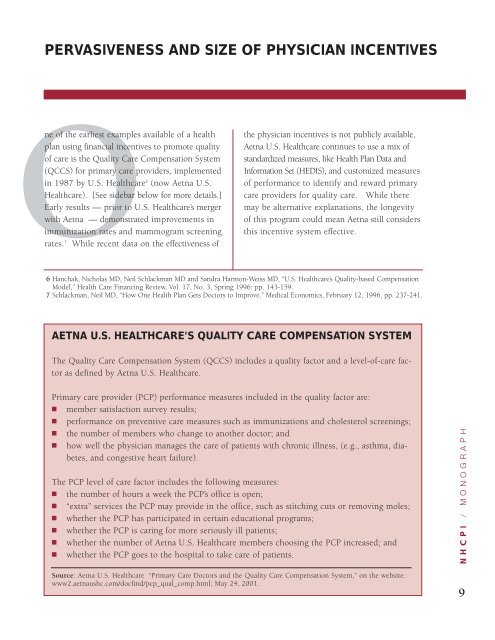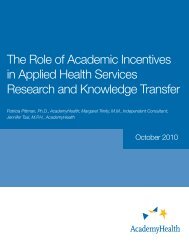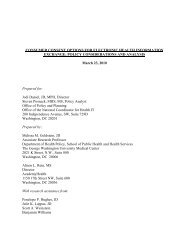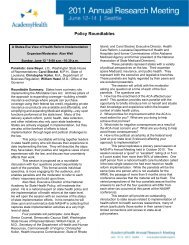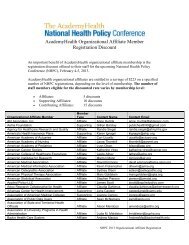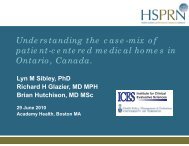The Growing Case for Using Physician Incentives to - AcademyHealth
The Growing Case for Using Physician Incentives to - AcademyHealth
The Growing Case for Using Physician Incentives to - AcademyHealth
Create successful ePaper yourself
Turn your PDF publications into a flip-book with our unique Google optimized e-Paper software.
PERVASIVENESS AND SIZE OF PHYSICIAN INCENTIVES<br />
One of the earliest examples available of a health<br />
plan using financial incentives <strong>to</strong> promote quality<br />
of care is the Quality Care Compensation System<br />
(QCCS) <strong>for</strong> primary care providers, implemented<br />
in 1987 by U.S. Healthcare 6 (now Aetna U.S.<br />
Healthcare). [See sidebar below <strong>for</strong> more details.]<br />
Early results — prior <strong>to</strong> U.S. Healthcare’s merger<br />
with Aetna — demonstrated improvements in<br />
immunization rates and mammogram screening<br />
rates. 7 While recent data on the effectiveness of<br />
the physician incentives is not publicly available,<br />
Aetna U.S. Healthcare continues <strong>to</strong> use a mix of<br />
standardized measures, like Health Plan Data and<br />
In<strong>for</strong>mation Set (HEDIS), and cus<strong>to</strong>mized measures<br />
of per<strong>for</strong>mance <strong>to</strong> identify and reward primary<br />
care providers <strong>for</strong> quality care. While there<br />
may be alternative explanations, the longevity<br />
of this program could mean Aetna still considers<br />
this incentive system effective.<br />
6 Hanchak, Nicholas MD, Neil Schlackman MD and Sandra Harmon-Weiss MD, “U.S. Healthcare’s Quality-based Compensation<br />
Model,” Health Care Financing Review, Vol. 17, No. 3, Spring 1996: pp. 143-159.<br />
7 Schlackman, Neil MD, “How One Health Plan Gets Doc<strong>to</strong>rs <strong>to</strong> Improve.” Medical Economics, February 12, 1996, pp. 237-241.<br />
AETNA U.S. HEALTHCARE’S QUALITY CARE COMPENSATION SYSTEM<br />
<strong>The</strong> Quality Care Compensation System (QCCS) includes a quality fac<strong>to</strong>r and a level-of-care fac<strong>to</strong>r<br />
as defined by Aetna U.S. Healthcare.<br />
Primary care provider (PCP) per<strong>for</strong>mance measures included in the quality fac<strong>to</strong>r are:<br />
member satisfaction survey results;<br />
per<strong>for</strong>mance on preventive care measures such as immunizations and cholesterol screenings;<br />
the number of members who change <strong>to</strong> another doc<strong>to</strong>r; and<br />
how well the physician manages the care of patients with chronic illness, (e.g., asthma, diabetes,<br />
and congestive heart failure).<br />
<strong>The</strong> PCP level of care fac<strong>to</strong>r includes the following measures:<br />
the number of hours a week the PCP’s office is open;<br />
“extra” services the PCP may provide in the office, such as stitching cuts or removing moles;<br />
whether the PCP has participated in certain educational programs;<br />
whether the PCP is caring <strong>for</strong> more seriously ill patients;<br />
whether the number of Aetna U.S. Healthcare members choosing the PCP increased; and<br />
whether the PCP goes <strong>to</strong> the hospital <strong>to</strong> take care of patients.<br />
NHCPI / MONOGRAPH<br />
Source: Aetna U.S. Healthcare “Primary Care Doc<strong>to</strong>rs and the Quality Care Compensation System,” on the website:<br />
www2.aetnaushc.com/docfind/pcp_qual_comp.html; May 24, 2001.<br />
9


